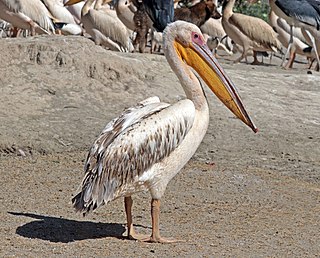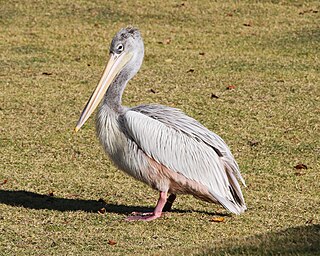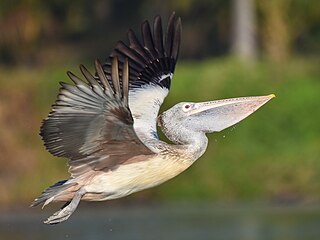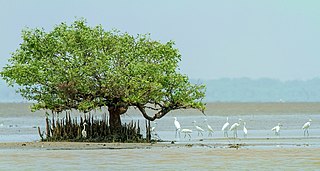
The great white pelican also known as the eastern white pelican, rosy pelican or simply white pelican is a bird in the pelican family. It breeds from southeastern Europe through Asia and Africa, in swamps and shallow lakes.

The pink-backed pelican is a bird of the pelican family. It is a resident breeder in the swamps and shallow lakes of Africa and southern Arabia; it has also apparently been extirpated from Madagascar.

The spot-billed pelican or gray pelican is a member of the pelican family. It breeds in southern Asia from southern Iran across India east to Indonesia. It is a bird of large inland and coastal waters, especially large lakes. At a distance they are difficult to differentiate from other pelicans in the region although it is smaller but at close range the spots on the upper mandible, the lack of bright colours and the greyer plumage are distinctive. In some areas these birds nest in large colonies close to human habitations.

Pulicat Lake is the second largest brackish water lagoon in India,, measuring 759 square kilometres (293 sq mi). A major part of the lagoon lies in the Tirupati district of Andhra Pradesh. The lagoon is one of three important wetlands that attracts northeast monsoon rain clouds during the October to December season. The lagoon comprises the following regions: Pulicat Lake, Marshy/Wetland Land Region (AP), Venadu Reserve Forest (AP), and Pernadu Reserve Forest (AP). The lagoon was cut across in the middle by the Sriharikota Link Road, which divided the water body into lagoon and marshy land. The lagoon encompasses the Pulicat Lake Bird Sanctuary. The barrier island of Sriharikota separates the lagoon from the Bay of Bengal and is home to the Indian Space Research Organisation's Satish Dhawan Space Centre.

Kolleru Lake is one of the largest freshwater lakes in India and forms the largest shallow freshwater lake in Asia. 15 kilometers away from Eluru and 65 km from Rajamahendravaram, the lake is located between the Krishna and Godavari river deltas. Kolleru Lake is located in the Eluru district in the state of Andhra Pradesh. The lake is fed directly by water from the seasonal Budameru and Tammileru rivulets, and is connected to the Krishna and Godavari irrigation systems by over 67 major and minor irrigation canals. This lake is a major tourist attraction. Many birds migrate here in winter, such as Siberian crane, ibis, and painted storks. The lake was an important habitat for an estimated 20 million resident and migratory birds, including the grey or spot-billed pelican. The lake was declared as a wildlife sanctuary in November 1999 under India's Wildlife Protection Act of 1972, and designated a wetland of international importance in November 2002 under the international Ramsar Convention. The wildlife sanctuary covers an area of 308 km2.
Point Calimere Wildlife and Bird Sanctuary is a protected area in Tamil Nadu, South India, covering 21.47 km2 (8.29 sq mi) along the Palk Strait where it meets the Bay of Bengal at Point Calimere at the southeastern tip of Nagapattinam District. It was created in 1967 for the conservation of the blackbuck and also hosts large congregations of waterbirds, especially greater flamingos. It has been classified as an Important Bird Area.
Sullurupeta is a town in Tirupati district of Andhra Pradesh, India. It is a municipality and the headquarters of Sullurupeta mandal and Sullurupeta revenue division. It serves as a gateway to Satish Dhawan Space Centre(SDSC) at Sriharikota.

Ranganathittu Bird Sanctuary, is a bird sanctuary in the Mandya District of Karnataka in India. It is the largest bird sanctuary in the state, 40 acres (16 ha) in area, and comprises six islets on the banks of the Kaveri river. The sanctuary has been designated on 15 February 2022 as a protected Ramsar site since 2022.

Dibru-Saikhowa National Park is a national park located in Dibrugarh and Tinsukia districts, Assam, India. It was designated a Biosphere Reserve in July 1997 with an area of 765 km2 (295 sq mi), including a core area of 340 km2 (130 sq mi) and a buffer zone of 425 km2 (164 sq mi).

Sultanpur National Park (formerly Sultanpur Bird Sanctuary) is located at Sultanpur village on Gurugram-Jhajjar highway, 15 km from Gurugram, Haryana and 50 km from Delhi in India. This covers approximately 142.52 hectares.

Kokkarebellur Bird Sanctuary, usually shortened by the colloquial usage to Kokrebellur is a village in Maddur taluk of Mandya district of Karnataka, India. The village is named after the painted stork, which is called "kokkare" in the native Kannada language. This bird nests here in large numbers every year. The village is situated near Maddur between the cities of Mysore and Bangalore. Apart from painted storks, spot-billed pelicans are also found here in large numbers. Both are classified to be near threatened in the IUCN Red List. The village is one of the 21 breeding sites of those birds in India.

Coringa Wildlife Sanctuary is an estuary situated near Kakinada in Andhra Pradesh, India. It is the third largest stretch of mangrove forests in India with 24 mangrove tree species and more than 120 bird species. It is home to the critically endangered white-backed vulture and the long billed vulture. Mangroves are a group of trees and shrubs that live in the coastal intertidal zone, with a dense tangle of prop roots that make the trees appear to be standing on stilts above the water. This tangle of roots allows the trees to handle the daily rise and fall of tides; hence, the mangrove forest gets flooded at least twice per day. The roots also slow the movement of tidal waters, causing sediments to settle out of the water and build up the muddy bottom.

The Godavari–Krishna mangroves are a mangrove ecoregion of India's eastern coast.
Kaggaladu is a village in the Sira Taluk of Tumkur district in the south of Karnataka, India. It is located 9 km to the northwest of Sira, a town on the Sira-Changavara Main Road. Since 1999, trees in Kaggaladu have been a breeding ground and haven for painted storks and grey herons. The heronry was first made known to the outside world in 1999 by Wildlife Aware Nature Club, an NGO based in Tumkur.

The state of Karnataka in South India has a rich diversity of flora and fauna. It has a recorded forest area of 38,720 km2 which constitutes 55% of the geographical area of the state. These forests support 25% of the elephant population and 20% of the tiger population of India. Many regions of Karnataka are still unexplored and new species of flora and fauna are still found.
Chitrangudi Bird Sanctuary locally known as "Chitrangudi Kanmoli" is a .4763 km2 (0.1839 sq mi) Protected area declared in 1989 and a part of Chitrangudi village, Mudukulathur Taluk, Ramanathapuram District, Tamil Nadu, India. It is adjacent to Kanjirankulam Bird Sanctuary. It is notable as a nesting site for several migratory heron species that roost in the prominent growth of Babul trees there. International name: Chitragudi and Kanjirankulam Bird Sanctuary, IBA Code: IN261, Criteria: A1, A4i. The sanctuary has been designated as a protected Ramsar site since 2021.
Sur Sarovar, often referred to as Keetham Lake, is a picturesque lake off the Agra-Delhi national highway (NH-19). The Agra Bear Rescue Facility, a facility for saving Sloth bears dedicated to rehabilitating previously captured "dancing bears," is located next to it. Since 2020, the lake has been recognized as a Ramsar site that is protected.

Vedanthangal Bird Sanctuary is a bird sanctuary in the Madurantakam taluk of the Chengalpattu district in the Indian state of Tamil Nadu. Established in 1936, it is the oldest wildlife sanctuary in India. It has been designated as a protected Ramsar site since 2022. More than 40,000 birds have been recorded in the sanctuary during the migratory season every year.

Housing more than 200 resident and wintering bird species, Chennai has long been a haven for bird watchers. It is one of the few urban areas in India with diverse range of birds including greater flamingo, black baza, osprey, Indian eagle-owl, Coppersmith barbet, Spot billed pelican and pied avocet can be seen. The following are some known birding hotspots in and around Chennai.

Ratargul Swamp Forest is a freshwater swamp forest located in Gowain River, Fatehpur Union, Gowainghat, Sylhet, Bangladesh. Ratargul was once thought to be the only swamp forest in Bangladesh, and one of the few freshwater swamp forests in the world. Later, more swamp forests namely Jugirkandi Mayabon, Bujir Bon and Lokkhi Baor swamp forest were discovered in Bangladesh.
















